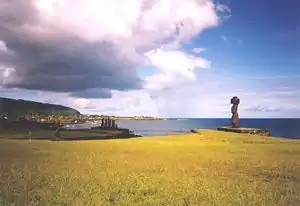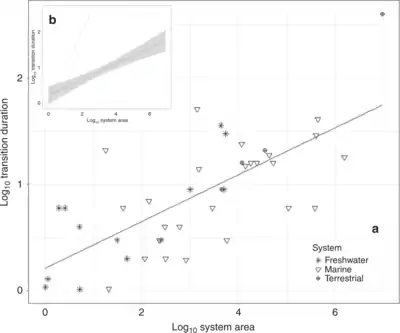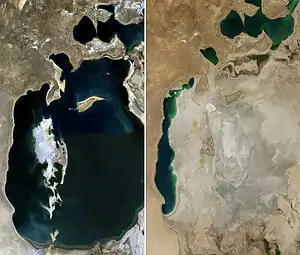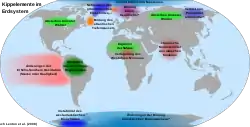Ecosystem collapse
An ecosystem is considered collapsed when its unique biotic (characteristic biota) or abiotic features are lost from all previous occurrences.[1] Ecosystem collapse could be reversible and is thus not completely equivalent to species extinction.[2]

Ecosystem collapse can lead to catastrophic declines of carrying capacity and mass extinction (known as ecological collapse), and can also pose existential risk to human populations.[3]
Despite the strong empirical evidence, anticipating collapse is a complex problem. The collapse can happen when the ecosystem's distribution decreases below a minimal sustainable size, or when key biotic processes and features disappear due to environmental degradation or disruption of biotic interactions. These different pathways to collapse can be used as criteria for estimating the risk of ecosystem collapse.[4][5] Although states of ecosystem collapse are often defined quantitatively, few studies adequately describe transitions from pristine or original state towards collapse.[6][7]
Examples of collapsed ecosystems

The Rapa Nui subtropical broadleaf forests in Easter Island, formerly dominated by an endemic Palm, are considered collapsed due to the combined effects of overexplotaition, climate change and introduced exotic rats.[9]
The Aral Sea was an endorheic lake between Kazakhstan and Uzbekistan. It was once considered one of the largest lakes in the world but has been shrinking since the 1960s after the rivers that fed it were diverted for large scale irrigation. By 1997, it had declined to 10% of its original size, splitting into much smaller hypersaline lakes, while dried areas have transformed into desert steppes.
The regime shift in the northern Benguela upwelling ecosystem is considered an example of ecosystem collapse in open marine environments.[10] Prior to the 1970s sardines were the dominant vertebrate consumers, but overfishing and two adverse climatic events (Benguela Niño in 1974 and 1984) lead to an impoverished ecosystem state with high biomass of jellyfish and pelagic goby.[11]
Risk of collapse
The concept of ecosystem collapse is used in the IUCN Red List of Ecosystems to establish categories of risk for ecosystems. The category Collapsed is used as the end-point of risk assessment. Other categories of threat (Vulnerable, Endangered and Critically Endangered) are defined in terms of the probability or risk of collapse.[1]
See also
References
- Keith, DA; Rodríguez, J.P.; Rodríguez-Clark, K.M.; Aapala, K.; Alonso, A.; Asmussen, M.; Bachman, S.; Bassett, A.; Barrow, E.G.; Benson, J.S.; Bishop, M.J.; Bonifacio, R.; Brooks, T.M.; Burgman, M.A.; Comer, P.; Comín, F.A.; Essl, F.; Faber-Langendoen, D.; Fairweather, P.G.; Holdaway, R.J.; Jennings, M.; Kingsford, R.T.; Lester, R.E.; Mac Nally, R.; McCarthy, M.A.; Moat, J.; Nicholson, E.; Oliveira-Miranda, M.A.; Pisanu, P.; Poulin, B.; Riecken, U.; Spalding, M.D.; Zambrano-Martínez, S. (2013). "Scientific Foundations for an IUCN Red List of Ecosystems". PLOS ONE. 8 (5): e62111. doi:10.1371/journal.pone.0062111. PMC 3648534. PMID 23667454. Retrieved 8 September 2018.
- Boitani, Luigi; Mace, Georgina M.; Rondinini, Carlo (2014). "Challenging the Scientific Foundations for an IUCN Red List of Ecosystems" (PDF). Conservation Letters. 8 (2): 125–131. doi:10.1111/conl.12111.
- Kareiva, Peter; Carranza, Valerie (2018). "Existential risk due to ecosystem collapse: Nature strikes back". Futures. 102: 39–50. doi:10.1016/j.futures.2018.01.001. ISSN 0016-3287.
- Gigante, Daniela; Foggi, Bruno; Venanzoni, Roberto; Viciani, Daniele; Buffa, Gabriella (2016). "Habitats on the grid: The spatial dimension does matter for red-listing" (PDF). Journal for Nature Conservation. 32: 1–9. doi:10.1016/j.jnc.2016.03.007. hdl:10278/3671359.
- Bland, L.; Regan, T.; Ngoc Dinh, M.; Ferrari, R.; Keith, D.; Lester, R.; Mouillot, D.; Murray, N.; Anh Nguyen, H.; Nicholson, E. (2017). "Meso-American Reef: Using multiple lines of evidence to assess the risk of ecosystem collapse". Proceedings of the Royal Society B. 284 (1863): 20170660. doi:10.1098/rspb.2017.0660. PMC 5627190. PMID 28931744. Retrieved 9 September 2018.
- Bland, L.; Rowland, J.; Regan, T.; Keith, D.; Murray, N.; Lester, R.; Linn, M.; Rodríguez, J.P.; Nicholson, E. (2018). "Developing a standardized definition of ecosystem collapse for risk assessment". Frontiers in Ecology and the Environment. 16 (1): 29–36. doi:10.1002/fee.1747.
- Sato, Chloe F.; Lindenmayer, David B. (2018). "Meeting the Global Ecosystem Collapse Challenge". Conservation Letters. 11 (1): e12348. doi:10.1111/conl.12348.
- Cooper, Gregory S.; Willcock, Simon; Dearing, John A. (10 March 2020). "Regime shifts occur disproportionately faster in larger ecosystems". Nature Communications. 11 (1): 1175. Bibcode:2020NatCo..11.1175C. doi:10.1038/s41467-020-15029-x. ISSN 2041-1723. PMC 7064493. PMID 32157098.
- Mieth, A.; Bork, H. R. (2010). "Humans, climate or introduced rats – which is to blame for the woodland destruction on prehistoric Rapa Nui (Easter Island)?". Journal of Archaeological Science. 37 (2): 417. doi:10.1016/j.jas.2009.10.006.
- Bland, Lucie M.; Watermeyer, Kate E.; Keith, David A.; Nicholson, Emily; Regan, Tracey J.; Shannon, Lynne J. (2018). "Assessing risks to marine ecosystems with indicators, ecosystem models and experts". Biological Conservation. 227: 19–28. doi:10.1016/j.biocon.2018.08.019. ISSN 0006-3207.
- Heymans, Johanna J.; Tomczak, Maciej T. (2016). "Regime shifts in the Northern Benguela ecosystem: Challenges for management". Ecological Modelling. 331: 151–159. doi:10.1016/j.ecolmodel.2015.10.027. ISSN 0304-3800.
- Timothy M. Lenton, Hermann Held, Elmar Kriegler, Jim W. Hall, Wolfgang Lucht, Stefan Rahmstorf, Hans Joachim Schellnhuber (2008). "Tipping elements in the Earth's climate system". PNAS. 105 (6): 1786–1793. doi:10.1073/pnas.0705414105.CS1 maint: multiple names: authors list (link)


